Software as a Service (SaaS) is the present and future of software.
Gone are the days when you’d use a disk to install software onto a single computer. SaaS is much more convenient, flexible, and cost-effective.
More and more businesses are seeing the benefits of SaaS, especially as remote work becomes the norm for many companies.
If you’re a SaaS company just starting out, you need to develop an effective sales model.
Here are the steps you can use to choose the right SaaS model for your organization.
What is a SaaS sales model?
A SaaS sales model is the defined model for selling your web-based software. Your model determines how you will sell your software to your clients, acquire new clients, and upsell or retain your existing clients.
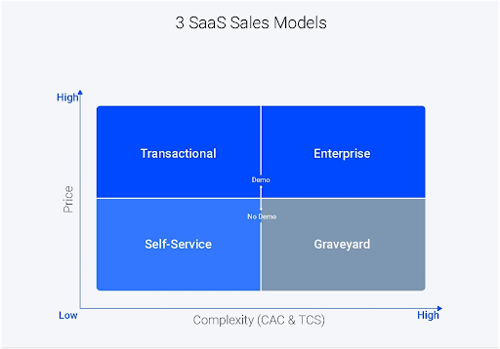
There are several types of sales models, and each one has different benefits for different businesses. Some of the most popular SaaS sales models include:
- Enterprise sales
- Transactional sales
- Self-service sales
- Referral sales
Enterprise sales
Enterprise SaaS products typically come with a higher price point, making sales lower in volume. HubSpot is one SaaS company that experienced explosive growth through targeting enterprise sales.
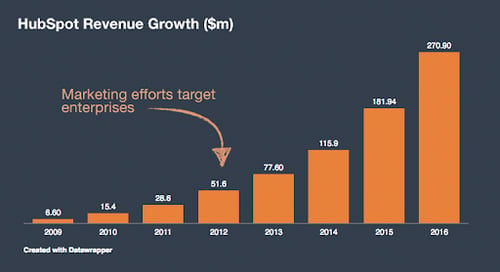
This type of software provides useful solutions that can be difficult to implement and may need a high level of support or training to use them effectively.
Some examples of enterprise SaaS include:
- Content management systems (CMS)
- Knowledge management software
- Resource planning software
Enterprise SaaS selling requires a highly experienced and knowledgeable team that’s able to pitch your software to the right types of organizations. They should know the product inside out and demonstrate the benefits to customers in the hope of closing the deal.
Enterprise billing can include different subscription types and often requires recurring billing software to manage. Annual billing might be the most suitable method, as well as the option of annual billing paid monthly. Given the high value of the software, you’ll want to secure long-term contracts with your customers.
You might also need to factor in additional consultation and implementation costs for organizations looking for a customized form of your software.
Transactional sales
Transactional sales are the most common type of SaaS model, providing effective software-as-a-service solutions for small and medium-sized businesses.
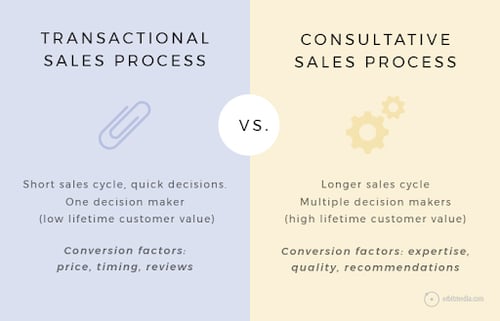
These types of software are package-based but can be customized to a degree. Customers expect high levels of support, regular updates, and various resources to help them use the software effectively.
As this type of software often comes with a higher price point, there is a perceived level of risk in signing up.
Customers will want to know that what they’re buying provides value, meaning the sales process can take some time.
Some examples of transactional SaaS include:
- Social media management software
- Cloud storage solutions
- Customer service platforms
- Marketing automation software
An effective internal sales team is required to help sell the software to clients. Alongside your sales team, you may have sales reps based outside your company working on commission.
You’ll also want to think about having engaging online content that can help generate interest from potential customers in the hope of converting them into sales.
Self-service sales
Self-service sales are high volume and low price to allow you to generate a high number of subscriptions. Software tends to be easier to use, minimizing the support needed for customers to get started.
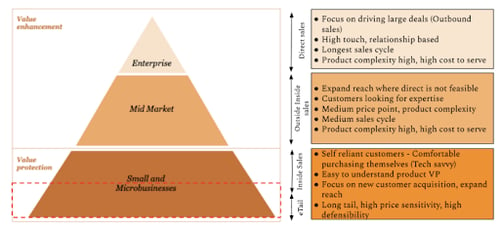
Some examples of self-service SaaS include:
- Media subscription services (Spotify, Netflix),
- Product subscriptions (Hello Fresh, shaving subscriptions)
- Health-based subscriptions (Peloton, keto diet, and fitness programs)
Unlike other types of sales models, self-service sales require next to no sales activity, with the majority of revenue coming from your business’s marketing activities. Having a dedicated sales team here could be a big expense for something that can be achieved through effective marketing.
With self-service sales, marketing teams should focus their efforts on raising awareness of products and targeting different audiences.
Software should be easy to subscribe to, and support should be available as needed.
These types of subscriptions can be easy to start, but they’re also the easiest to end, usually requiring no direct contact with an agent.
Referral systems
Referral systems can be a profitable, additional sales model for your business. More than half of business professionals say the majority of their customers come from referrals.
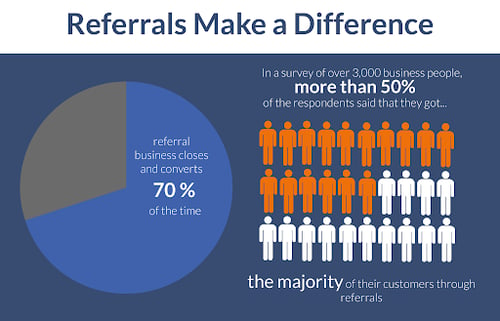
By enabling referrals as part of your SaaS customer success strategy, you can turn your customers into sales reps, allowing them to earn something while also bringing further subscribers your way.
Rewards for referrals could be monetary, or they could be in exchange for discounts on subscription fees.
Choosing the most appropriate sales model for your company will help give your business the best chance of success.
With this understanding of popular SaaS sales models, we can review the steps for choosing the best model for your company.
1. Define your key sales metrics
These metrics can help you monitor performance and make informed decisions so that you can grow your business.
Some of the key SaaS sales metrics include:
Monthly recurring revenue (MRR)
Launching a SaaS business requires an upfront investment.
You’ll not only need to design and launch your product, but it’s also going to cost money to acquire your customers through marketing and sales channels.
As your customers, especially monthly subscribers, pay smaller amounts continuously over time, it can take time to build up a regular cash flow for your business.
Understanding your MMR will help you predict your earnings for the month ahead. The higher the number, the healthier your business. It’s worked out by calculating your total number of customers times your average billed amount.
Customer acquisition cost (CAC)
Establishing how much it costs to acquire each new customer can help you make more informed decisions about your marketing strategy. CAC is one of the most vital metrics for SaaS, providing insight into what works and what doesn’t to bring new customers on board.
Your CAC cost is measured by working out the total cost of your marketing activities during a set period or campaign and dividing it by the number of new customers acquired as a result.
Revenue per customer
Understanding how much revenue each customer generates is a key component of your revenue operations. It can give you some amazing insights into your business’ growth.
It can also give you a basis for upselling plans and products to your customers, encouraging them to increase their spending with you.
You can easily calculate your average revenue per customer by dividing your MMR by the number of active accounts using your software.
CAC payback period
Once you know your customer acquisition costs and customer revenue, you can then work out how long it takes to receive ROI. It’s possible to establish how long it takes to break even before you start making a profit.
To calculate your CAC payback period, you need to divide the CAC by the revenue generated by a customer.
Churn
Your churn rate is another important metric that can help you establish long-term performance predictions. Churn tells you how many people leave your services each month.
A high churn rate can indicate a problem with your software causing people to leave.
To address churn, ask departing customers the reason behind their decision and reach out to long-term customers to see what makes them stay.
Dealing with a high churn number can be difficult. However, if you take swift action, you can bring your churn rate back down.
Lifetime value
Calculating your lifetime value will help your business make predictions around future profits and even customer behaviors. Based on the average subscription length and your average customer revenue, you can then calculate how much revenue you could receive in the future.
Your lifetime value figures can help you balance your other costs, such as acquisition costs, to establish whether your business can become profitable.
It can also help you identify your most valuable customers across each of your different customer groups to help you determine where to place more of your efforts.
2. Understand the criteria for choosing your sales model
Choosing the right sales model for your business depends on a few main criteria, including:
Your target market
- Who are you selling your SaaS product to?
- Are you targeting individual users, large enterprises, or both?
- Have you achieved product-market fit?
Your target market could consist of multiple segments, but you’ll need to make sure you understand each segment’s needs to adjust your sales model accordingly.
Your audience size
Not all SaaS products have mass appeal. Your audience size can be large or small, depending on how niche your product is.
Having a larger target audience may mean you need to employ more salespeople or invest more money into your marketing activities to help you reach as many people as possible.
The type of product you sell
Some SaaS products require little involvement from a support perspective. Others, however, may need detailed demonstrations and training to decrease time-to-value for the customer and help a buyer determine whether your product is the right solution for them.
3. Know your ideal buyer
Most businesses have a clear, defined customer set to base their selling activities on:
Business to consumer (B2C)
A business that markets its products to the public, or your typical consumer.
Business to business (B2B)
B2B businesses sell to other businesses. This can include both for-profit and non-profit businesses. Selling to business often requires a more detailed process due to decision-making chains, budgets, etc.
Business to government (B2G)
B2G businesses will market their products to government agencies. These will typically have to enter a bidding process to ensure fairness, with a product being marketed according to the agency’s specific requirements.
Knowing who you are selling to will influence your marketing activities. Many companies misidentify these types of sales, having an impact on their customer acquisition.
4. Analyze your competitive landscape
Do you know who your competitors are?
Identifying your main competitors can help you learn lessons through reverse-engineering their sales strategies. This can help give you the basis for your own sales strategy, meaning you don’t have to start from scratch.
5. Understand your business positioning and needs
Looking inward at your company can also help you decide on the right sales model. The size of your company, and how many people you have to carry out sales activities, can help you establish which model is the most appropriate.
You need to consider the scalability of your company should things take off - can you grow your team quickly if your business takes off?
You need to give some thought to the pointers above and see where your business fits.
SaaS sales models are not a one-size-fits-all solution, but you can take what you know about your business and adopt one of the sales models below to help your business stand the best chance of success.
6. Know when to use multiple models at once
While your business might be better suited to one SaaS model over another, there are instances where you might want to use multiple models.
For instance, if you are an email marketing SaaS, which is focused more around B2B rather than B2C, then you might want to focus more on enterprise sales and embed self-serve in your product to cater to your B2C audience.
Additionally, there are some tried & tested sales models that can add some additional revenue to your pipeline like:
Cross-selling
If you have additional products or upgrades to sell, then using another sales model could help you boost your revenue. Cross-selling requires a knowledgeable and persuasive team to encourage customers to make further purchases.
Selling to previous customers
Do you want to try to reconnect with previous customers in the hope of bringing them back? An alternative sales model can help bring in additional revenue for your business.
Selling on support channels
Seeking additional sales through support channels can be another way to adopt a second sales model for your business.
Through your retention team, you could provide alternative subscription packages, discounts, and more to help you hold onto your customers.
Choose the right type of SaaS sales model and set your business up for success
Choosing the right type of SaaS sales model is important for the future of your business. SaaS is going to continue to grow in the coming years, in line with evolving business practices and more and more companies embracing digital transformation.
There are several insightful successful SaaS selling tips you can try to help you boost your sales, letting you in on some of the tricks of the trade. There are also a lot of lessons to learn from top SaaS companies as to the type of sales models they adopt, and what works to get customers on board.
Your SaaS company has the potential to soar. Get ready to make the most of the growing interest in SaaS by choosing the right sales model for your needs.



